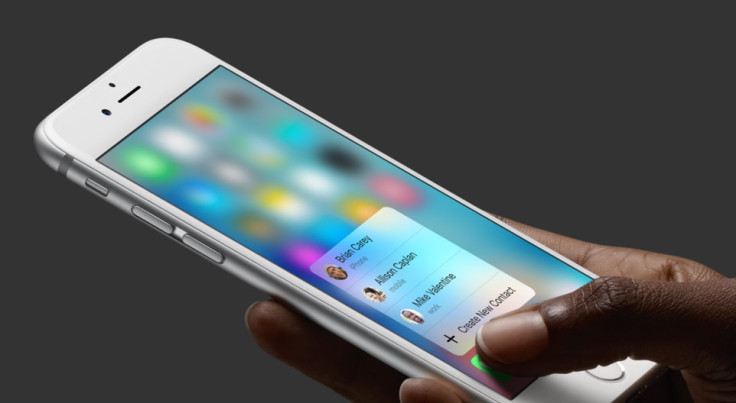iPhone 6s vs Samsung Galaxy S6: Which flagship smartphone is right for you?

Now that the iPhone 6s has finally been announced by Apple, the question on everyone's lips is how does it compare to its closest rival, the Samsung Galaxy S6? Below we have lined the two handsets up for their first face-off.
iPhone 6s vs Samsung Galaxy S6: The specs

The rivalry between Apple and Samsung's flagship smartphones is closer than ever this year, as the iPhone 6s gets a significant front and rear camera upgrade to bring it within touching distance of the Galaxy.
Samsung keeps the upper hand as far as screen size and resolution are concerned, but Apple's joker card, its 3D Touch technology, could win over consumers already using Force Touch on the Apple Watch and new MacBooks. Opting to stick with 16GB of storage for the base model could pose a problem for Apple, as the Galaxy S6 starts with double that.
iPhone 6s vs Samsung Galaxy S6: Size and weight
At 6.8mm, the Galaxy S6 is slightly thinner than the 7.1mm iPhone 6s, which in turn is 0.2mm thicker than the iPhone 6 – believed to be down to Apple using tougher 7000 series aluminium to prevent a repeat of last year's 'bendgate' fiasco, which saw some iPhones bend in the pockets of their owners. After three generations of aesthetic mediocrity, Samsung pulled out all of the stops with the Galaxy S6 and has arguably produced a more attractive handset than the iPhone – especially in its curved Galaxy S6 edge form factor.
iPhone 6s vs Samsung Galaxy S6: Display
Force Touch is the biggest difference here. New for the iPhone 6s (although technically Huawei got there first with the Mate S), Force Touch is a way for the screen to know how hard you are pressing on it. The technology has previously appeared on the Apple Watch and new MacBooks, and will give application and game developers a whole new set of gestures to work with.
Elsewhere, the other major differences between the new hero handsets are the size and resolution of their displays. As usual, the Samsung is larger – at 5.1in compared to the iPhone's 4.7in, the same as the year-old iPhone 6. The same phone also has a greater resolution, at 1440 x 2560 compared to the iPhone's 750 x 1334.

This gives the S6 a pixel density of 577 per inch compared to 326 with the iPhone – a substantial difference, but as the iPhone's individual pixels cannot be seen with the naked eye we have to wonder if there is the need to have a resolution any higher. Samsung clearly thinks so, and so too does Sony, which recently announced the Xperia Z1 Premium, with a 4K screen and a little over 800 pixels per inch.
We suspect pixel density and resolution will both be overlooked in favour of screen quality, accuracy and brightness – all areas which Samsung has improved upon with the S6 to close the gap on Apple.
iPhone 6s vs Samsung Galaxy S6: Camera
Up from 8MP last year, the new iPhone 6s has a 12MP rear camera. This lags slightly behind the 16MP sensor in the back of the Galaxy S6, but as with screen resolution the quality of a camera is often dependent on much more than raw numbers. Samsung and Apple both have excellent track records when it comes to smartphone photography, so it'll be interesting to see how the two newest models compare with each other.
The iPhone's upgrade means it can now shoot 4K video –just like the Samsung can. As for front shooters, both have 5MP sensors to take high-quality selfies.
iPhone 6s vs Samsung Galaxy S6: Processor, RAM and storage
Comparing the processors of the iPhone and Samsung Galaxy S range has always been like comparing apples with oranges. For starters, Apple never discloses the clock speed or number of cores – or how much RAM each iPhone has – and Samsung has recently moved to outfitting flagships with its own chips. All we can say is the Galaxy S6 uses an octa-core processor with one quad-core chip running at 1.5Ghz and a second running at 2.1GHz. The iPhone 6s uses Apple's A9 processor, and while we don't know any of its technical specifications, we do know that it's 70% faster than the A8 found in the iPhone 6.

Storage is easier to compare. Neither phone has an SD card slot – once a strong positive for Samsung's flagships – and both stretch up to 128GB at the top end. But where the Samsung starts at 32GB and has a middle option of 64GB, Apple has stuck with just 16GB for its entry-level iPhone 6s, joined by a mid-range 64GB. It's a crushing shame that the world hasn't seen the back of 16GB iPhones, because for many users this simply isn't enough, while it is widely known the extra cost to Apple of using 32GB storage chips instead is minimal. Please Apple, let this be the last iPhone to start at 16GB...
iPhone 6s vs Samsung Galaxy S6: Price
Following a recent price cut, the Galaxy S6 starts at £499 (down from £559) on Samsung's website, rising to £639 for the 64GB model and £719 for 128GB. The iPhone 6s opens for preorder on 12 September, goes on sale on the 25th, and will cost £539 for the 16GB model, £619 for 64GB and £699 for 128GB.
© Copyright IBTimes 2025. All rights reserved.






















